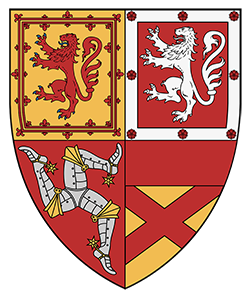Alexander Stewart - Duke of Albany
Alexander Stewart, 1st Duke of Albany, Second Creation, was a 15th-century Scottish prince known for his turbulent relationship with his brother King James III, his political intrigues involving England and France, and his repeated attempts to seize control of Scotland.

Alexander was born in Stirling, Scotland, around 1454. He was the second surviving son of King James II of Scotland and Mary of Guelders. He was created Duke of Albany sometime before 1458, and received the earldom of March, lordship of Annandale, and lordship of the Isle of Man.
In 1460, he left for Guelders, home of his mother's family. Four years later, he was captured by the English on his return to Scotland and soon released. As he grew of age, he began to take part in the defense of Scotland, quickly being appointed Lord High Admiral of Scotland and Warden of the Marches.
Alexander married Lady Katherine, daughter of William Sinclair, 3rd Earl of Orkney. They would have four children, including: Alexander, Andrew, and Margaret. Alexander and Katherine's marriage was dissolved in 1478.
In 1479, his earldom of March was seized after he was suspected of conspiracy, and he fled to France. Where he gained King Louis XI's favor, however, the King of France would not support him in military action against his brother, King James III of Scotland.
In 1480, Alexander married Anne de la Tour d'Auvergne, daughter of Bertrand VI, Count of Auvergne. They would have one son, John, and a daughter, Maud.
In June of 1482, Alexander crossed into England and made a treaty with King Edward IV at Fotheringhay Castle. In the Treaty of Fotheringhay, Alexander promised to hold Scotland under English suzerainty and to deliver the southern shires into English possession in return for Edward IV's assistance.
Alexander Stewart then marched at the head of an English army, 20,000 strong, to Berwick with the Duke of Gloucester, future King Richard III. They laid siege to the town, which would change hands for the last time between England and Scotland. Alexander would then march to Edinburgh with a smaller army.
King James III was captured at Lauder Bridge as he headed to Edinburgh to face Alexander. James was then held prisoner in Edinburgh Castle. Alexander, with some loyal earls, began to form a new government for Scotland, with Alexander as the acting lieutenant-general of Scotland. He then took the earldom of Mar and regained his former lands and titles.
In December of 1482, a parliament was held at which Alexander Stewart had hoped to have his role as lieutenant-general confirmed. However, George Gordon, 2nd Earl of Huntly, one of Scotland's most powerful magnates, stood against him. Gordon was angered by Alexander taking the earldom of Mar, as he had designs on that title for himself. Moreover, King James III convinced several other earls to return loyalty to him, including Lord Darnley, 1st Earl of Lennox, who was the keeper of Edinburgh Castle. The Earl of Atholl and the Bishop of Dunkeld also showed loyalty to James. The parliament passed several acts that contradicted Alexander's ambitions, causing him to flee to Dunbar between Christmas and New Year's.
On January 2nd, 1483, Alexander Stewart, Duke of Albany, made a failed second attempt to seize King James III. On February 11th, the King of England, Edward IV, promised to provide aid to Albany, who managed to force his brother James III into a humiliating indenture. However, with the death of King Edward IV on April 9th, 1483, Albany lost his primary source of power and fled south, allowing a garrison of English soldiers to occupy Dunbar Castle as he left.
In July of 1484, Albany invaded Scotland with James Douglas, 9th Earl of Douglas. They were defeated at the Battle of Lochmaben on July 22nd, where Douglas was captured and Albany fled to France.
Alexander Stewart, Duke of Albany, in a joust in Paris, was killed by a splinter from the lance of his opponent, Louis XII, Duke of Orleans. He was laid to rest at the high altar in the Couvent des Célestins in Paris. The titles of March and Dunbar returned to the crown of Scotland.
